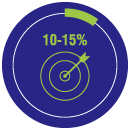The first question to be answered is to identify just what we’re talking about. Why can’t we just talk about learning? There are some fundamental reasons we should consider thinking about performance instead of just learning.
At the core, our outcomes, our impact, doesn’t come from learning. We achieve outcomes based upon learning new skills, yes, but they have to be the right ones, developed appropriately, and refined until they have the needed outcomes. Learning is a part of the process, not the end goal in and of itself.
To put it another way, we could create experiences that achieve learning outcomes, yet aren’t of value to the organization. There are a variety of ways we could go wrong. We could be making sure people know information that isn’t critical to their jobs, or that doesn’t get even thought about, let alone applied, when it’s relevant. Which all too often characterizes where our organizations go wrong.
-

Estimates suggest that only 10-15% of our training investments have a real impact.
-

Turned around, that suggests that we’re wasting 85-90% of our money!
How do we remedy this? It comes from thinking differently about what we’re here for. We need a ‘performance’ perspective.
Performance (not learning)
So, what is a performance perspective? Quite simply, it’s looking to improve performance in the organization. Let’s be clear, that’s not learning, except as a means to an end. Also, not our only means! The full spectrum of ways to support outcomes depends on the barriers to performing. Some of them are addressable by L&D, and others are not. For instance, if people can do it, but aren’t, the problem likely isn’t one that skills training can solve. Similarly, there are times such as when things don’t happen very frequently that don’t make sense to train and can instead be better served by instructions available as needed. And more.
Too often, what L&D has focused on is ‘learning’. We provide onboarding, compliance training, and meet demands for courses on sales, operations, leadership, and more. The focus can be that folks have the experience, like it, or even pass a knowledge test at the end of it. L&D regularly takes content (PPTs and PDFs), digests and presents it, and sometimes adds a quiz to test whether the knowledge has been acquired.
However, that approach is problematic. Subject matter experts don’t have access to roughly 70% of what they do. They have access to what they know, on the other hand. Thus, courses can become information dumps, which can provide the appearance of learning, but not actually achieve it. There’s reliable evidence that “telling’ isn’t training”, as it’s become known. In cognitive science, it’s referred to as ‘inert knowledge’; accessible but unlikely to be activated and applied when useful.
Thus, focusing on learning can lead us astray. Our organizations need people able to do things that need to be done. That’s the real goal; obtaining the outcomes needed. To put it another way, we need people to perform organizational tasks, not just learn them. When we look at it that way, we should see that a focus on outcomes, on performance, is what we need. Then we have to think about what that means we do differently.
Implications
What does this mean we do differently? We need to put a performance focus across our activities. That means we think about performance in our processes. What does that mean?
We need to ensure that we’re looking for the needed changes. We need to analyze why we’re not achieving the outcomes we need. Then we need to identify the barriers that are preventing that success. We next need to look at what changes can remedy the situation and implement them. Finally, we need to see whether our changes have solved the problem. Or not.
Note that this can work for new areas to be addressed. If you’ve new skills necessary for a new process or service, or to accommodate new industry trends, you can determine what the performance should be. Then you can state a baseline of zero. You are using a performance perspective that actually tightens up your skilling, too.
This shouldn’t sound new or controversial. This is what we’ve always supposed to have been doing, it’s just that we’re too frequently not taking this approach. As such, it’s worth elaborating what and why performance is important.
To truly make an impact in our organizations, we must shift our focus from mere learning to enhancing performance. By understanding the barriers to performance and implementing targeted changes, we can ensure that our efforts lead to meaningful outcomes. This approach not only optimizes our training investments but also aligns our initiatives with the core needs of the organization.
If you’re ready to dive deeper into how you can apply a performance-based approach in your workplace learning and eLearning strategies, download our eBook, Rethinking Learning: Focus on Performance.
Discover actionable insights and practical frameworks that will help you transform your learning programs into powerful performance drivers.



















